Physical Address
304 North Cardinal St.
Dorchester Center, MA 02124
Accidental eye injuries account for 8%–14% of all injuries at children’s hospitals, and these accidental eye injuries led to visual deficit in 35%–49% of cases. This chapter will discuss the classification of eye injuries in children and review the acute, sub-acute, and long-term approach to eye injury with the purpose of serving as a quick reference guide to the on-call pediatric ophthalmologist. It is of paramount importance that the ophthalmologist dealing with ocular trauma in childhood remains mindful of the possibility of non-accidental/abusive/inflicted injury. This is particularly so if the extent of injury is out of proportion with the history given by the caregivers (see Chapter 71 ).
Terminology is critical to ensure standardization of diagnosis, treatment, and prognostication. The first eye trauma classification system used the globe as the reference and qualified the accident as causing a closed- or open-globe injury before characterizing the mechanism ( Fig. 70.1 ). For closed-globe injuries, the mechanism is termed a contusion if a blunt object causes damage, a lamellar laceration if a sharp object causes a partial-thickness injury to the eye wall (cornea or sclera), and a superficial foreign body if the object is retained. The classification is further defined by anatomical considerations with Zone I involving the eye wall (bulbar conjunctiva, cornea, or sclera), Zone II involving the anterior segment (anterior chamber to posterior lens capsule including pars plicata), and Zone III involving the posterior segment (retina, choroid, and optic nerve). For open-globe injuries, the mechanism is subdivided into sharp objects causing lacerations and blunt objects causing rupture. Subcategories of laceration include penetrating (in and out through the same wound), perforating (in one wound and out another), and intraocular foreign body. Similar to closed-globe injury, anatomical considerations define Zone I as the cornea, Zone II as the limbus to 5 mm posterior to the limbus, and Zone III as the sclera >5 mm posterior to the limbus. In both closed- and open-globe injuries, the most posterior zone is the classification when multiple zones are involved. Although this system has worked well for globe-based injuries, periocular and associational eye injuries are not described. These were categorized in a later schema defining the eyelids, orbit, and lacrimal system as adnexal injury and the visual and vision-related sequelae trauma involving face, head, or polytrauma as associational injuries. Pediatric ophthalmologists should approach each injury with these classification systems in mind, and they should always remember that a comprehensive evaluation beyond the most obviously injured structure is essential to avoid missing occult injury.
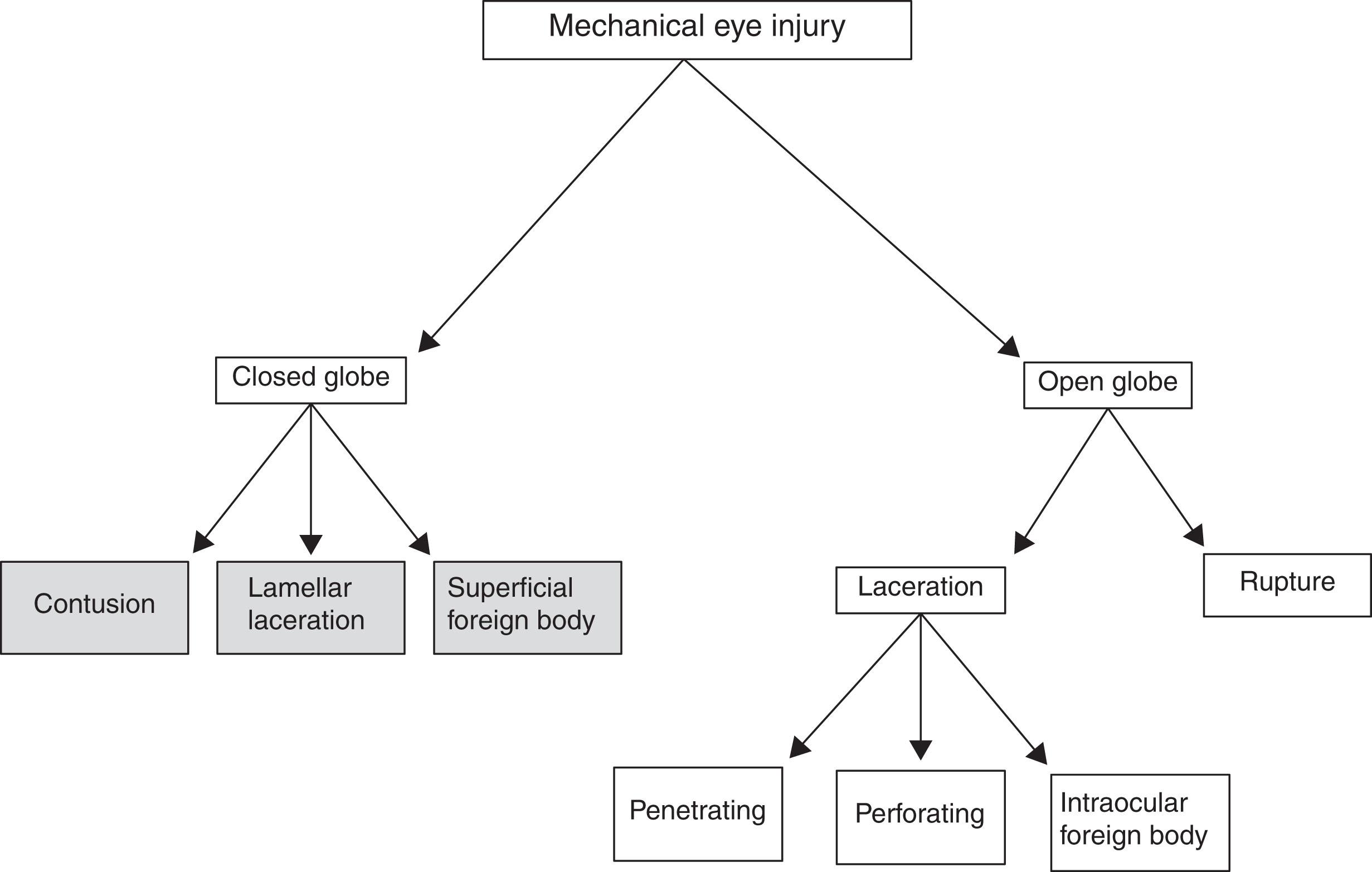
The eyelids and lacrimal system are critical in maintaining ocular surface homeostasis for clear vision and for cosmesis. Periocular trauma resulting in eyelid injury may be divided into a contusion or laceration. In addition to evaluating the eyelid, the clinical examination must consist of an evaluation of (1) ocular structures for closed- or open-globe injury, (2) ocular motility for orbital fracture or retro-orbital hematoma, and (3) evaluation for neurological injuries of cranial nerves 2, 3, 4, 5 (divisions 1 and 2), and 6; the work-up of these further injuries is mentioned in subsequent sections.
Eyelid contusion results from blunt periocular trauma and may manifest as ecchymosis, hematoma, edema, and/or ptosis ( Fig. 70.2 ). Clinicians encountering this injury may often be told that the child collided during play. For ecchymosis, hematomas, and edema, parents may describe a gradual or rapid increase that may be worrisome. Acute management starts with judicious use of orbital imaging (computed tomography imaging exposes children to radiation and magnetic resonance imaging is not quick and may require general anesthesia) to determine if there is any other orbital injury. Clinicians may consider application of ice to the eyelid for comfort as this has been shown to reduce postoperative pain (but not speed resolution of ecchymoses, hematoma, or edema in postoperative adult patients after blepharoplasty ). Subacute management involves observation as most eyelid contusions will clear over days to weeks. Frequent skin lubrication with topical emollients may prevent breakdown and risk of secondary infection. Long-term follow-up focuses on checking vision development especially in amblyogenic-aged children in whom the initial ophthalmic evaluation may have been limited. In addition, long-term evaluation should look for traumatic ptosis, which is not well described in the pediatric population but does occur. An adult study shows that levator palpebrae superioris muscle aponeurosis dehiscence from stretching during a hematoma, cicatricial changes, or nerve damage are the etiologic mechanisms. In each of these cases, recovery over 3–6 months may occur and so deferring surgical intervention for the ptosis until that time is ideal. In cases of potential amblyopia, earlier intervention may need to be considered.
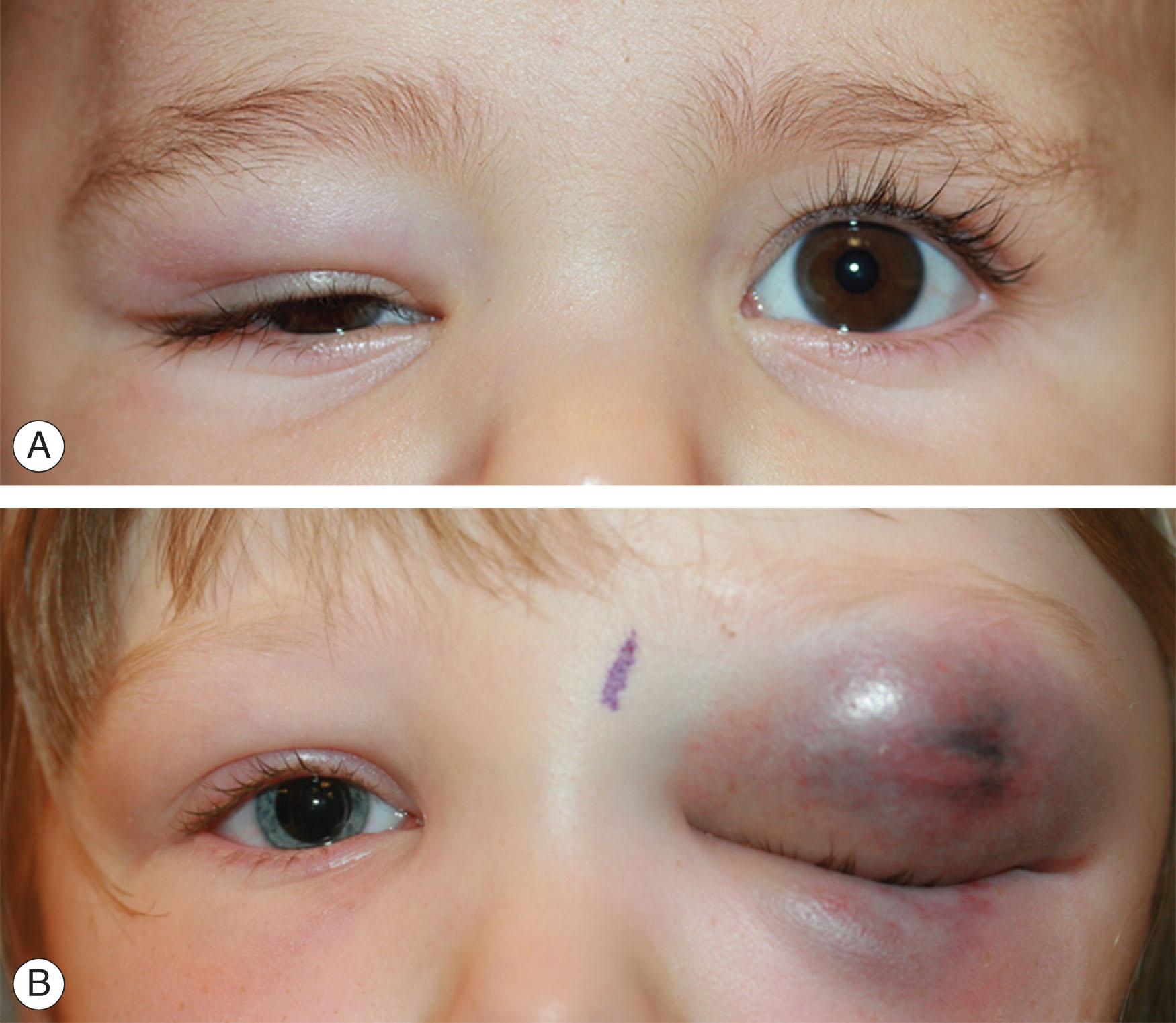
Eyelid lacerations may be divided into three categories: non-marginal, marginal, and lacrimal-system involving. Eyelid lacerations occur secondary to animal bites, sports, falls, altercations, or motor vehicle accidents. The acute management of an eyelid laceration is based on category. The first category of an eyelid laceration is the non-marginal laceration. Non-marginal eyelid lacerations need to be explored to understand the depth of injury ( Fig. 70.3 ). Attention to the mechanism of injury may provide clues that innocuous-appearing laceration may harbor deeper injuries. It is essential to clean dried blood and probe the depth of a laceration with a cotton tip applicator prior to closure. Identifying orbital fat prolapse indicates orbital septal violation prompting a consideration that the wound is much deeper into the orbit and may hide a foreign body. Occasionally, imaging is necessary to identify the presence of a foreign body though vegetable matter such as wood or leaves, and plastic may be difficult to identify on computed tomography imaging. Tracks of air in the orbit in these cases may be a clue that an object is retained. Vegetable matter must be removed expeditiously; inert foreign bodies (e.g. steel BBs) may be left in place for later management if difficult to access at presentation. Layered closure of the marginal laceration may be necessary if the orbicularis muscle is splayed. Absorbable suture such as 6-0 to 8-0 polyglactin 910 is ideal to close the muscle. Closure of the skin may be achieved with 6-0 plain gut suture, cyanoacrylate tissue adhesive, or a non-absorbable suture such as polypropylene suture. The cyanoacrylate-based tissue closure has been shown to be faster and has been shown to be equivalent in cosmesis to suture. It may also avoid the need for anesthesia. Sub-acute management of non-marginal lacerations involves ensuring appropriate wound healing and that non-absorbable sutures are removed in 5–7 days after injury. Retained foreign bodies and infection will present as edema and erythema in this sub-acute period 3-10 days after injury. Long-term evaluation of non-marginal lacerations involves monitoring for ptosis or reverse ptosis from injury to the levator palpebrae superioris muscle or lower eyelid retractors, respectively.
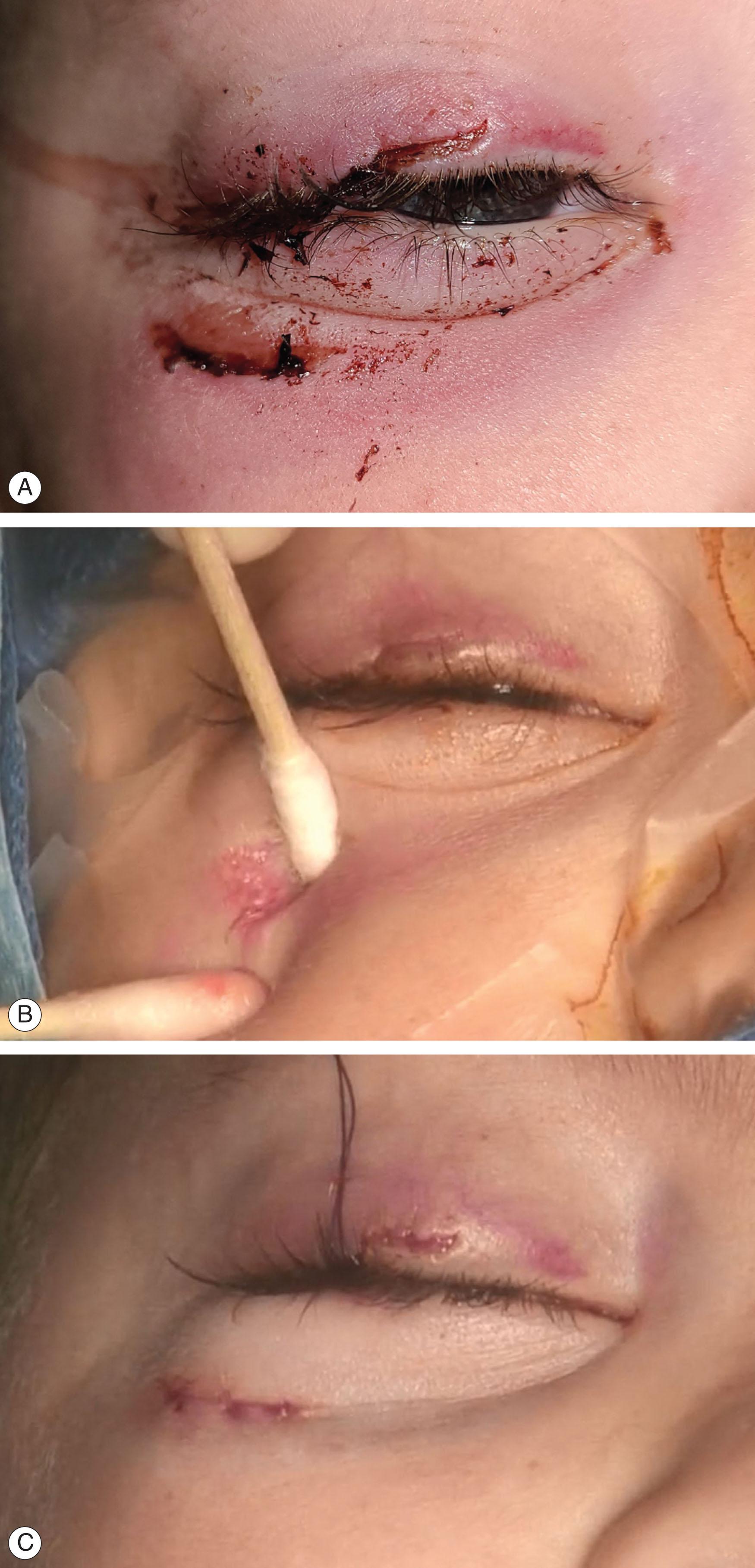
Marginal eyelid lacerations without lacrimal system involvement are the second category. These lacerations must be repaired to provide ocular surface lubrication with each blink, to avoid post-injury epiphora, and to provide good reconstructive cosmesis. Acute management involves closure of the cut edges of the eyelid margin with good eversion of the wound margin to prevent notching when healed. Most traditional marginal eyelid closures propose use of non-absorbable suture such as silk, but this requires subsequent removal. However, excellent functional and reconstructive outcomes are attainable with an absorbable suture obviating the need for any subsequent manipulation. The absorbable suture approach shown in Fig. 70.4 is well suited for young children. This technique consists of initially placing a vertical mattress suture at the posterior lamellar margin through the tarsus using a 6-0 polyglactin 910 (see Fig. 70.4A ). The marginal tarsus suture can then be followed by deeper tarsal interrupted sutures of 6-0 polyglactin 910 suture. Finally, skin closure with sub-ciliary, interrupted, 6-0 plain gut sutures completes the repair (see Fig. 70.4B ). Subacute management of marginal eyelid lacerations includes ensuring that suture is not rubbing on the ocular surface causing pain, redness, and corneal abrasion. When non-absorbable sutures are used for lid closure, they should be removed 7–10 days post injury. Long-term care includes ensuring that repair prevents epiphora and maintains clear vision for the child.
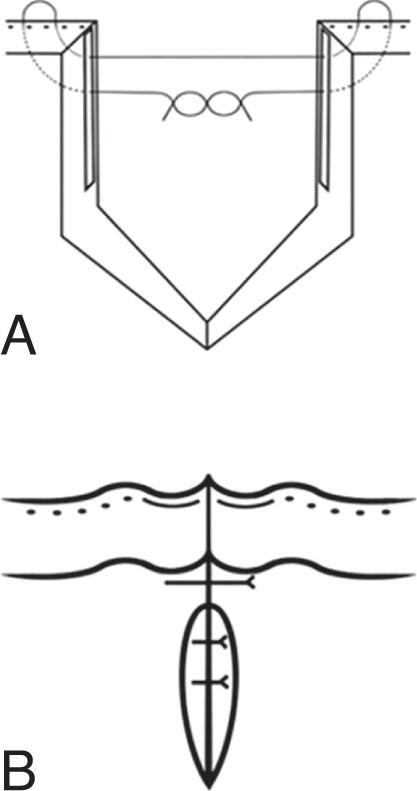
Eyelid lacerations with lacrimal system involvement are the third category. Lacrimal system lacerations must be stented and repaired expeditiously to prevent post-injury, chronic epiphora. Eyelid lacerations with lacrimal system involvement originate or extend nasal to the punctum of the upper and lower eyelids. Acute management of any medial eyelid laceration involves finding the location of the punctum to understand whether the lacrimal system is involved; any child with a dog-bite mechanism of eyelid laceration should be suspected to have lacrimal system involvement. The affected canalicular tract may be evaluated with irrigation to confirm involvement. Irrigation is performed by dilating the affected upper or lower eyelid punctum, inserting an irrigating cannula and syringe, and slowly injecting saline (with or without fluorescein) into the proximal canalicular system. If egress of fluid is seen from the laceration, lacrimal system violation is confirmed.
Lacrimal system repair begins with identifying the proximal and distal ends of the involved canaliculus. The proximal end is located by passing a dilator through the punctum at the eyelid margin, into the canalicular tract, and noting the tip of the dilator as it emerges within the laceration. The distal end of the canalicular tract may be identified by gently everting the anterior lamella of the nasal edge of the laceration and using a cotton-tip applicator to dry the subcutaneous tissue within the laceration. A lumen within the nasal-side tissue will be visualized, typically deeper and more posterior than imagined. Use of an operating microscope instead of surgical loupes may make it easier to find that distal lumen. In cases where the distal end is not identified easily, viscoelastic can be injected onto the nasal subcutaneous tissue to spread the tissue and to magnify the lumen or a pigtail probe may be introduced into the uninvolved punctum and rotated until it emerges through the cut canaliculus. The pigtail probe does pose a risk of damaging the canalicular system so care should be taken if used. Once the two ends of the canaliculus are identified, the lacrimal system is intubated. Numerous options exist including the bi-canalicular Crawford and Ritleng tubes and mono-canalicular Monoka, mini-Monoka, and Masterka tubes. Mono-canalicular intubation provides for easier removal 12 weeks post-repair using a blunt forcep and pulling the tube from its punctal plug in the office. The mini-Monoka tube requires no additional instrumentation. Prior to intubation, the mini-Monoka stent may be trimmed by placing it externally on the skin near the punctum and mapping the length needed to traverse the canaliculus to the lacrimal sac. Angling the trim makes it easier to insert the stent. Intubation begins by first passing the stent through the punctum and proximal canalicular tract, seating the plug within the punctum, and then introducing the stent into the distal canalicular tract and lacrimal sac after lubricating the end with viscoelastic ( Fig. 70.5 ). Following placement of the stent, direct re-anastomosis of the tissue surrounding the lumen of the canaliculus is performed with three interrupted, 7-0 polyglactin 910 sutures placed superior, anterior, and inferior to the canaliculus. Closure of the eyelid laceration follows as described previously. Sub-acute management of the lacrimal system injury involves ensuring that the stent is not rubbing on the ocular surface and removing the stent approximately 12 weeks post injury. Long-term management focuses on the functional outcome, including adequate tear drainage, the absence of epiphora, and clear vision for the child.
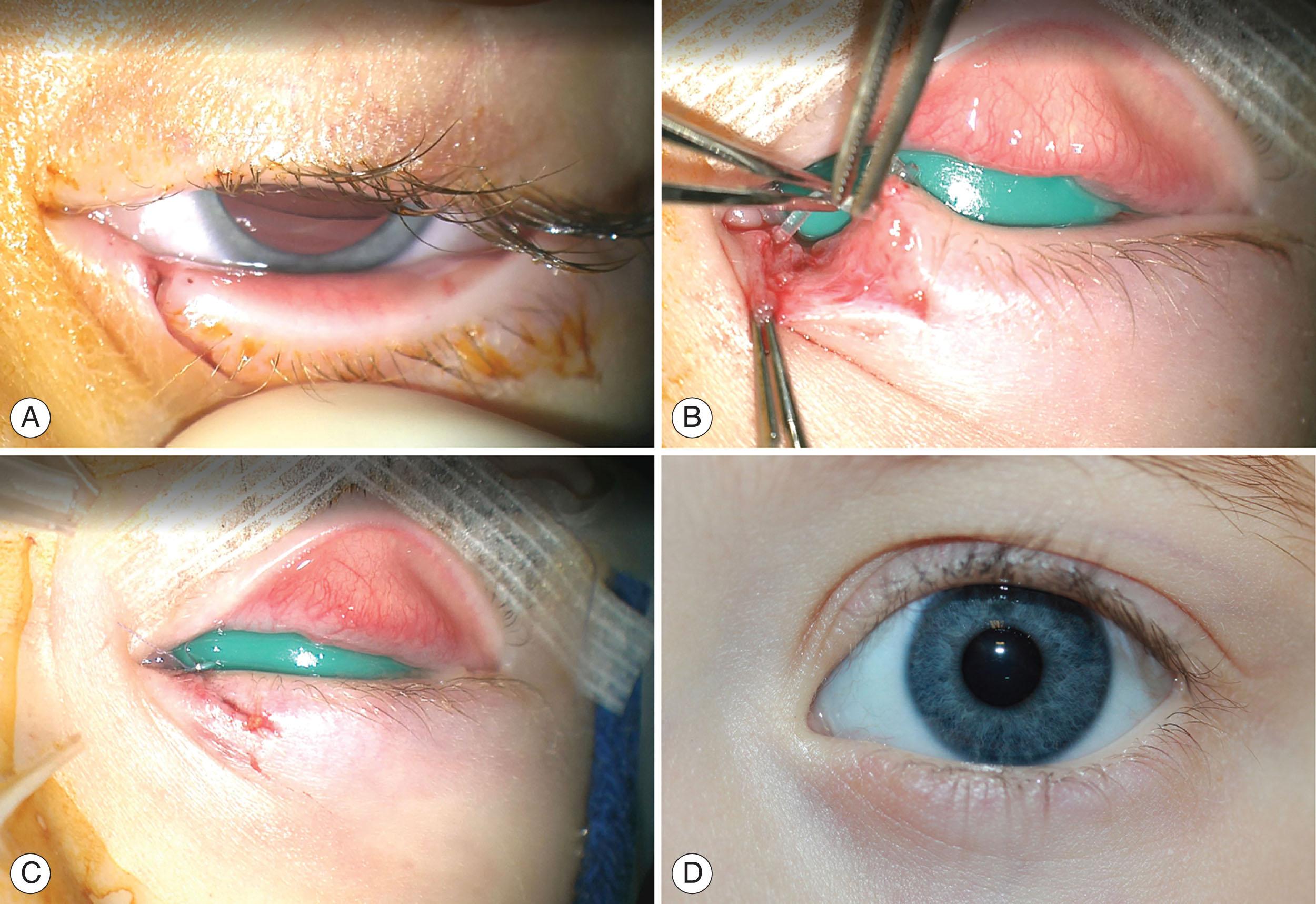
The orbit houses and protects the eye, the optic nerve, and the extraocular muscles. The orbit is bounded by the facial bones that make up the orbital floor, roof, and lateral wall as well as the fascial tissue of the orbital septum. Orbital trauma is classified as an adnexal injury and may be divided into a contusion or penetrating injury. Like eyelid trauma, acute management must start with a comprehensive ophthalmic examination to understand whether the globe is involved.
Orbital contusions are blunt force injuries to the bony orbit that lead to orbital edema, hemorrhage, or fractures. Orbital edema and hemorrhages are dangerous because the orbit is a compartment that may expand only slightly through proptosis of the globe. As fluid collects, the intraorbital pressure may rise causing compressive or stretch-related optic nerve injury, occlusion of the vasa nervorum affecting optic nerve perfusion, and/or occlusion of the central retinal artery. The clinical presentation consists of progressive eye pain with decreased vision and corresponding ophthalmic examination findings of decreased visual acuity, afferent pupillary defect, ophthalmoplegia, proptosis, difficulty opening the eyelids, and chemosis of the bulbar conjunctiva. Diagnosis is made on clinical suspicion and delay in orbital imaging should be avoided as time-to-treatment is correlated with outcome. When orbital imaging is performed, evaluation of the affected orbit should include assessment of post-septal serous or hemorrhagic fluid, anterior displacement of the globe, and tenting of the posterior globe ( Fig. 70.6 ). Treatment consists of emergent lateral canthotomy and inferior cantholysis. This procedure is performed by applying a hemostat clamp horizontally to the skin of the lateral canthus, cutting within this crush of tissue, retracting the loosened lower eyelid inferiorly, and then incising the lower eyelid canthal tendon vertically within the exposed tissue between the anterior and posterior lamellae of the eyelid ( Fig. 70.7 ). Subacute management of these contusions involves ensuring resolution of the edema and tracking for improvements in vision, proptosis, and ocular motility. A topical ophthalmic antibiotic ointment should be prescribed for the open wound of the lateral canthus. Topical emollients may be useful for the skin to avoid breakdown (and risk for superinfection) from the stretch. Long-term management involves repair of the lateral canthal tendon surgically if natural healing leaves lower eyelid laxity or ectropion.
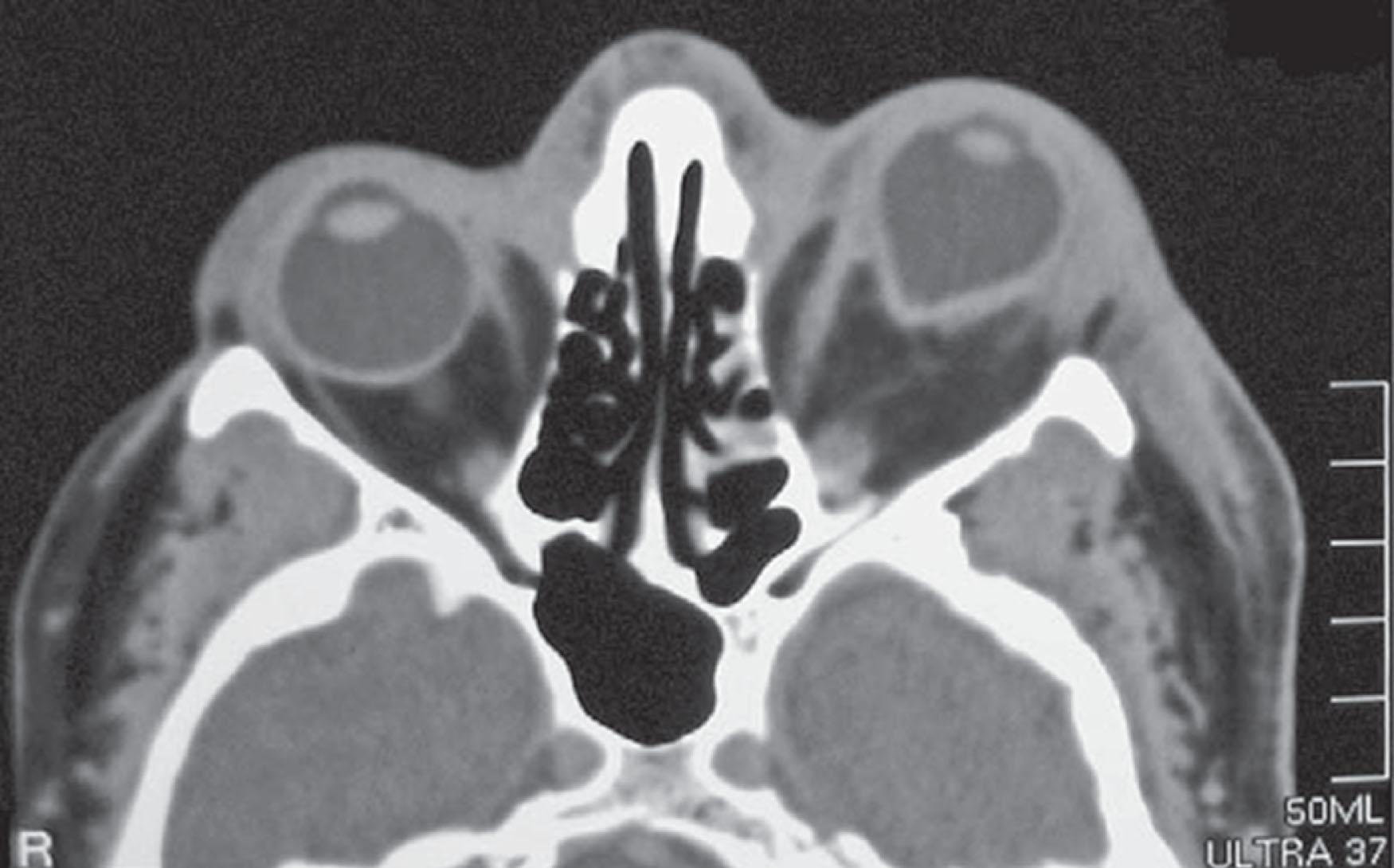
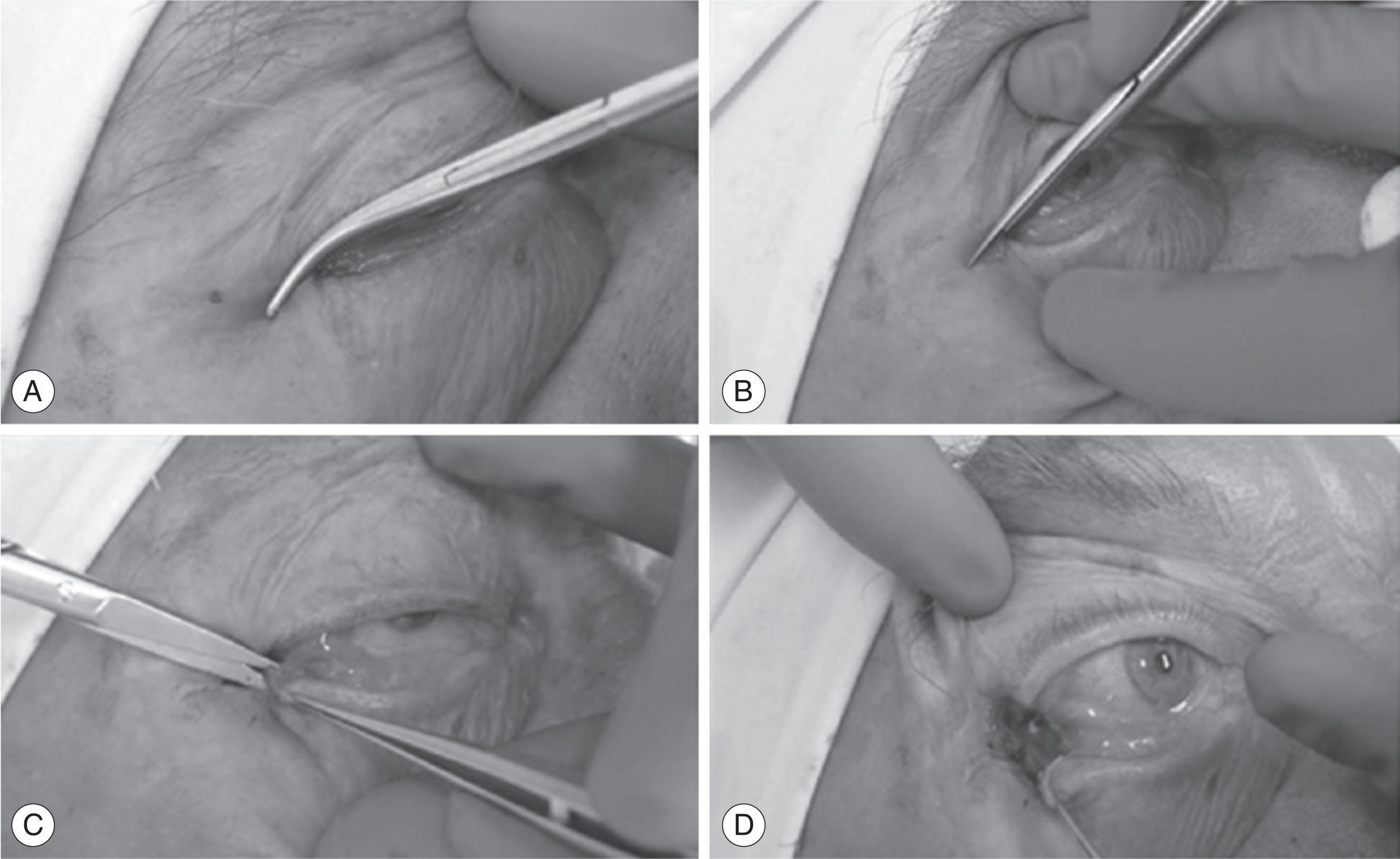
Orbital fracture is another injury associated with orbital contusion. Pediatric orbital fractures account for ~20% of facial fractures in all age groups between 0 and 18 years. One study (conducted primarily in adults but including some older children) showed that blunt injury, vision worse than counting fingers, roof fracture, diplopia in primary gaze, and conjunctival hemorrhage or chemosis increased the odds of having a serious ocular injury. Along with ocular injury assessment, ocular motility needs to be assessed acutely and immediately. Orbital fractures may result in entrapment of orbital fat and/or extraocular muscles especially in children in whom “trap-door” fractures are common due to the malleability of their facial bones. Entrapment is most common with floor fractures that capture the inferior rectus muscle ( Fig. 70.8 ), but they may also involve the medial wall. If entrapment is suspected clinically, monitoring of systemic vital signs including heart rate, blood pressure, respiratory rate, and oxygen saturation is essential due to the oculocardiac reflex, where tension on a rectus muscle stimulates the vagus nerve that induces bradycardia or even complete heart block. Prompt surgical intervention (ideally within 48 hours but definitely within 8 days ) with repair of the floor fracture when indicated and freeing of incarcerated muscle and/or orbital tissue will provide the best possible long-term outcome. Orbital roof fractures may lead to superior oblique muscle dysfunction inducing ocular misalignment inducing diplopia. In addition, these fractures may lead to pneumocephalus or cerebrospinal fluid leakage, and thus neurosurgical consultation is indicated. Larger fractures that cause prolapse of orbital tissue into the sinuses may lead to enophthalmos long term. These fractures should be repaired with re-position of the orbital tissues within the subacute period 7–10 days after injury. Long-term management of orbital fractures includes ensuring good motility and single binocular vision, good reconstructive outcome in terms of relative positioning of the globe without enophthalmos, and evaluation for ectropion that may occur from the surgical repair of the fracture.

Penetrating orbital trauma should be suspected with any periocular laceration or even those with conjunctival entry wounds. Acute management involves a comprehensive ophthalmic examination with attention to innocuous periorbital wounds that may hide foreign objects. Retained and non-retained foreign bodies pose a risk of infection. Retained foreign bodies such as vegetable matter must be removed expeditiously while inert foreign bodies may be left if difficult to access. Subacute management involves good adherence to a prophylactic, broad spectrum, oral antibiotic regimen to prevent infection, and long-term management involves ensuring return to functionality after the injury.
Attention to ocular motility is another key element of the initial survey of penetrating orbital trauma since it may reveal muscle contusion and laceration ; orbital imaging may be helpful in assessing the extraocular muscles. When full-thickness muscle lacerations are present, exploration to recover the posterior muscle stump is important acutely, and direct re-approximation to the globe (and avoidance of muscle stump to muscle stump re-anastomosis) is likely to give the best functional result. That said, if orbital edema and hemorrhage preclude easy recovery of the muscle, it is reasonable to wait for 2–6 months for the muscle to re-attach posteriorly, be evaluated for positioning by magnetic resonance imaging, and then surgically recovered. The subacute approach involves managing the diplopia for the patient with patching, fogging of a lens on the glasses, or prism therapy. Long-term management involves addressing residual strabismus 3–6 months from the injury once stability is achieved except in those in the amblyogenic age range, whose strabismus should be addressed earlier.
Last, a child should be evaluated for traumatic optic neuropathy following penetrating orbital trauma. Traumatic optic neuropathy will often manifest as a severe decrease in visual acuity and an afferent pupillary defect ( Fig. 70.9 ). Penetrating injuries accounted for 22% of cases of traumatic optic neuropathy and blunt injuries for 62% of cases in one large study. Concomitant injuries to the eye and adnexa should be managed acutely, but observation is likely the best treatment of traumatic optic neuropathy since corticosteroids, erythropoietin, and surgical decompression have not been shown to result in better outcomes. Subacute management involves initiation of protective eye wear at all times to prevent secondary trauma and injury to the fellow eye. Long-term management involves observing for some spontaneous improvement in visual function and observing for sensory strabismus.

Closed-globe eye injuries encompass damage to any structure of the globe without causing a break to the eye wall.
Become a Clinical Tree membership for Full access and enjoy Unlimited articles
If you are a member. Log in here